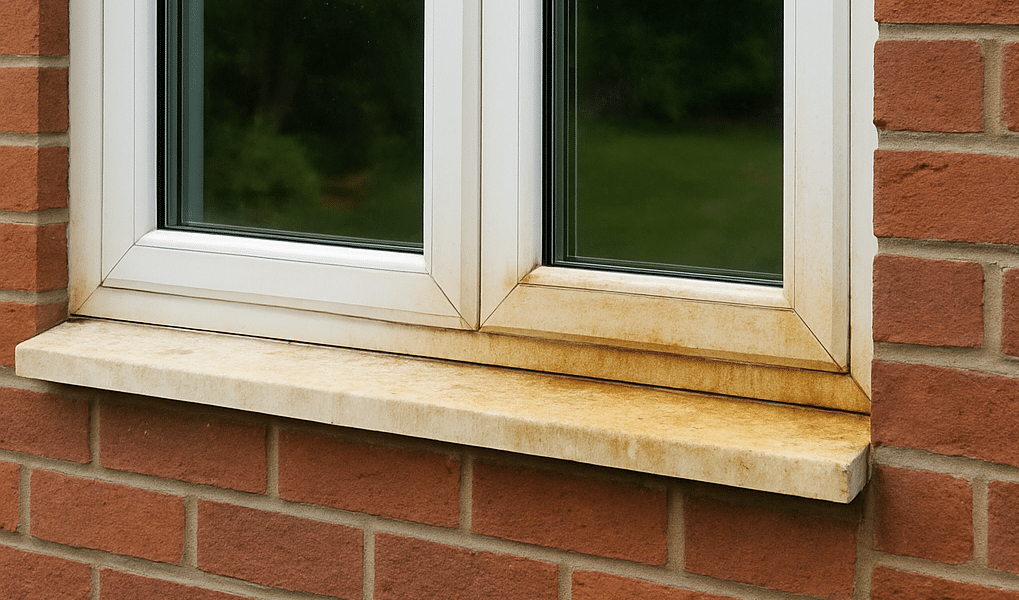When most people think of window cleaning, they imagine sparkling glass and a better-looking home, or just a luxury. But there’s more to it than good looks. Consistent regular window cleaning also protects the uPVC frames and sills that hold your windows in place from discolouration and permanent stains. This article outlines where these stains come from, how to prevent them, and how to remove them. Although regular window cleaning is the number one measure for prevention, there are DIY steps that you can take to save money and protect your windows.
How Dirt and Pollution Damage uPVC
uPVC (unplasticised polyvinyl chloride) is a remarkable and durable material, provided it is taken care of. Without regular cleaning, several common contaminants can gradually stain or discolour the surface:
- Airborne pollution and vehicle exhaust – Fine particles and oily residues settle and slowly yellow the surface. These include brake dust, tyre particles, and vehicle exhaust particles.
- Algae, mould, and mildew – Moisture on sills and seals encourages growth that leaves green or black marks. This is particularly a problem on South-facing uPVC windows and doors. Although algae, mould, and mildew can be removed, sometimes they leave behind dark and fairly large patches that are bonded to the surface of the window sills, frames, or even soffits and fascias.
- Tree sap and bird droppings – Natural acids can etch and dull the finish.
- Spider and insect droppings – These are often brown dots.
- Hard-water deposits – Rain or hose water can dry to leave mineral spots that darken over time. Although rain water itself doesn’t contain minerals, once it touches the roof it picks up lots of minerals from the roof tiles.
Left alone, these build up a film that embeds in the slightly textured surface of uPVC, making it look tired and aged. Many of these contaminants can be removed if washed within a few weeks, before they bond with the uPVC material.
The Long-Term Benefits of Regular Window Cleaning
Routine window cleaning removes this grime before it can bond with the material and leave stains behind.
Professional window cleaning:
- Maintains the original bright colour of frames and sills
- Reduces the need for harsh chemicals or costly restoration later
- Extends the overall life of your uPVC by preventing gradual surface erosion
- Maintains your home’s curb appeal.
If Discolouration Has Already Set In
Sometimes stains and discolouration happen despite best efforts, or maybe you have just moved into your new home and the previous owner neglected the uPVC frames. Here’s how to approach restoration safely:
Do:
- Use a mild uPVC cleaner or a solution of warm water with a small amount of washing-up liquid.
- Apply with a soft cloth or non-scratch sponge, working in gentle circular motions.
- For stubborn marks, a specialist uPVC cream cleaner can help.
Avoid:
- Abrasive pads or sandpaper—they can permanently scratch and dull the surface.
- Bleach or solvent-based products like acetone, which can strip the protective layer and cause yellowing.
- Pressure washers on a high setting; they can force water behind seals and damage them.
If heavy staining persists, a professional uPVC restoration service can often improve the appearance.
Keep Your Frames Looking New
Regular window cleaning is an easy, cost-effective way to protect your home’s investment. At Window Hero we don’t just make your glass gleam—we help your entire window system look its best and last longer.
Top Tip
Even if you are not ready to hire a regular window cleaner, we recommend that you wipe your window frames and sills with a damp cloth once a month to remove stains before they set in. This alone will save you thousands of pounds down the road.
We hope you found this post useful and informative.

